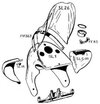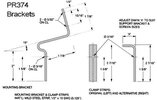Thanks Ian, I am at that point of determining where to drill SL1 fiberglass cowl for fit to SL3 bracket. Even though it may not match side/side exactly, it appears reasonable to simply drill.
BUT.... am considering the verticalness of the headlamp. D men what is the correct headlamp vertical position? It looks like Ds sit "tail high" , so?
I request photos of -
FF85 bracket
SL16 bracket
Also how do I cut out for speedo and gauges without damaging gel coat?
Craig,
I've seen the photos you've posted of your Comet on theVincent.com, It looks really good.
I haven't any experience with fiberglass but when cutting Plexiglas, lexan, etc .... I put a layer or two of masking tape on each side of where I'm cutting to prevent chipping and scratching. I've got a friend who works in the leisure boat industry, and see what he says, he's worked a quite a with fiberglass boats.
Now my turn to ask a question. What stops the fairing SL1 pivoting where it attaches to SL3 and tipping forward? Is it just the steering damper extension passing through the instrument panel, or am I missing something?
Steven


